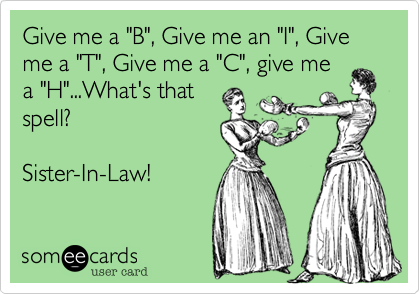Trending 24 Sister in Law Memes: If you have a sister-in-law as your best friend then you are the luckiest lady on the earth, save our collection of reading Now: Trending 24 Sister in law memes. Most of the sisters-in-law are observed as offensive or melodramatic or, you know, unresponsive. Tag your sister-in-law in reading Now: Trending 24 Sister in Law Memes.
The concept of “quantity of parenting” is a concept that affects the number of children a person has. Children are especially sensitive to the thoughts of their parents, and as a result, ideas that directly or indirectly promote a higher birth rate will reproduce themselves at a greater rate than concepts that discourage a higher birth rate would duplicate themselves at a lower rate.
It is a concept that enhances the percentage of children who will embrace the beliefs of their parents that is known as “efficiency of parenting.”
Read Now: Trending 24 Sister in Law Memes



A good example of a behavior in which one may anticipate a greater probability of meme-replication is cultural separatist. This is because the meme for separation provides a barrier to exposure to competing ideas.
Proselytic thoughts are those that are usually passed on to others other than one’s own offspring. As observed in many religious and political groups, ideas that promote the proselytization of a meme may replicate memes horizontally across a particular generation, spreading memes more quickly than parent-to-child meme transmissions.








Sibling-in-law
When it comes to the law, a sibling-in-law is either the spouse of one or more of your siblings, your spouse’s sibling, or the person who is married to a sibling of your spouse’s sibling.
According to etymology, male siblings-in-law are more commonly referred to as brothers-in-law, and female siblings-in-law are more commonly referred to as sisters-in-law.
The phrase “sibling-in-law” refers to the reciprocal relationship that exists between a person’s spouse and the spouse of a sibling of the person’s spouse. When one has a co-sibling in law (particularly, a co-sister for the wife of one’s sibling-in-law, or a co-brother for the husband of one’s sibling-in-law), this is referred to as co-sibling in Indian English.
Brother-in-law is a term used in “casual conversation” to express the relationship that exists between a person’s brother-in-law and the one who is speaking: Several times in the novel, William’s brother Charles refers to William as his brother-in-law (James is Charles’ brother-in-law here not by virtue of marrying Charles’ sister, but rather by virtue of being the brother of Charles’ wife), and James refers to William as his brother-in-law in a number of places.
There is a sense of kinship that exists between in-law siblings, as there does with all in-law couples. All of these are connections in which the individual does not have a direct blood tie to another person.
The children of one’s in-law siblings are referred to as simply nieces and nephews, with a distinction made between those born “by marriage” as opposed to those born “by blood” or those born “by adoption,” much as the children of one’s biological siblings are referred to as nieces and nephews.
Consequently, each of the four in-law siblings is double connected, as each of them has a connection to both his or her spouse and to his or her sibling, whereas the offspring of the two marriages are also double cousins. Whenever one set of siblings marries another set of siblings, the children of the two marriages are considered to be double cousins.













Preservational ideas
Preservational ideas are those that have the ability to persuade people who possess them to hang on to them for a lengthy period of time. Ideas that promote longevity in their hosts, or that leave their hosts especially resistant to leaving or replacing these ideas, increase the preservability of memes and provide protection from competition or proselytism from other memes, among other benefits.
Competing ideas and/or people who hold them are referred to as adversarial ideas because they encourage others who hold them to attack or destroy them. When a meme promotes hostility towards other memes, adversarial replication may provide a competitive advantage in the transmission of that message to other people.
Cognitive concepts are those that are regarded as sound by the majority of people who come into contact with them. Cognitively transmitted memes are highly reliant on a cluster of other ideas and cognitive characteristics that are already widely held in the community, and as a result, they tend to spread more passively than other types of meme transmission, such as word of mouth. Memes that are transmitted via cognitive transmission are not considered to be self-replicating.
Concepts that individuals embrace because they see some self-interest in embracing them are referred to as motivational ideas. Even while motivationally transmitted memes do not self-propagate in the strictest sense, this method of transmission is often seen in conjunction with memes that self-replicate in the efficient parental, proselytic, and preservational forms of replication.
Memes as distinct pieces of information
To begin with, Dawkins defined the meme as a word that “conveys the notion of a unit of cultural transmission, or of a unit of imitation” in his book The Meme Makers.
Mr. John S. Wilkins maintained the notion of a meme as a kernel of cultural imitation while highlighting the meme’s evolutionary aspect. He defined the meme as “the smallest unit of social cultural information in the context of a selection process that has a favourable or unfavourable selection bias that exceeds the meme’s endogenous tendency to change.”
The meme as a unit offers a simple method of addressing “a bit of idea copied from person to person,” independent of whether that piece of idea includes others or is part of a bigger meme that is being discussed. A meme may be made up of a single word, or it might be made up of the whole speech in which that word was first heard. A comparison may be drawn between this concept and the notion of a gene as a single unit of self-replicating information contained on a self-replicating chromosome.
However, although the identification of memes as “units” communicates their ability to reproduce as distinct, indivisible entities, it does not suggest that thoughts have become quantized or that “atomic” concepts exist that cannot be broken down into smaller parts. There is no set size for a meme. Susan Blackmore says that the melodies from Beethoven’s symphonies are often used to demonstrate the difficulties involved in delimiting memes as distinct entities and that this is a typical practice in the field. She points out that, although the opening four notes of Beethoven’s Fifth Symphony (About this sound listen (help info)) constitute a meme that has been extensively reproduced as a standalone unit, the whole symphony may be considered a single meme as well.